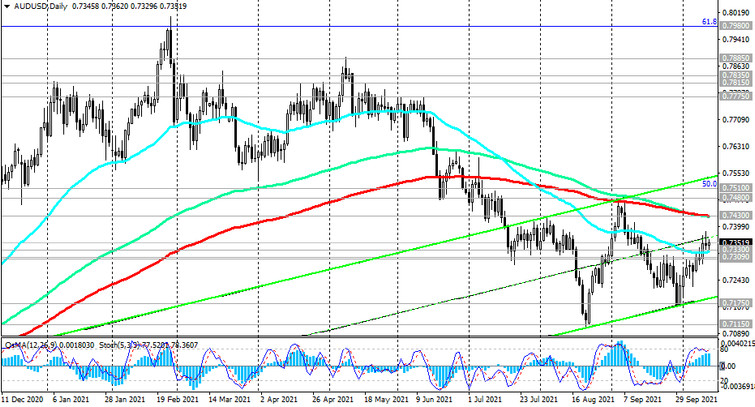In one of our previous reviews, we wrote that "the US dollar is falling against commodity currencies such as the Canadian, Australian and New Zealand dollars, the rise in quotations of which is largely due to the rise in energy prices".
And this trend is also observed today, despite the correctional decline in oil prices. On Monday, WTI crude oil futures hit highs since November 2014, rising above $ 81.20 a barrel, while Brent crude futures rose above $ 84.20 a barrel, highs since October 2018. One of the drivers of today's decline in oil prices was the news that negotiations on Iran's nuclear program may resume this week. This is probably why some participants in the oil market began to consider the potential increase in the supply of crude oil to the world market. Nevertheless, expectations of a cold winter, a well-thought-out OPEC policy of smoothly increasing the level of oil production, a rally in the gas market and expectations of a further recovery of the world economy contribute to maintaining positive dynamics in the oil market. This, in turn, will continue to support quotes for commodity currencies, in particular the Australian dollar, despite the RBA's commitment to continuing to pursue a soft monetary policy.
Today, the main European currencies such as the pound, franc and euro have also joined the strengthening process against the US dollar.
After the DXY dollar index hit a local multi-month high of 94.57 yesterday, DXY futures are traded near 94.26 today, as of this writing, 27 points below today's opening price.
Nevertheless, despite today's decline, the positive dynamics of the dollar and the DXY dollar index remains. The American economy continues to be one of the most resilient in the world. At the same time, the dollar is in demand as a defensive asset and ahead of the November meeting of the FRS, at which, as expected, its leaders will announce a partial reduction in the stimulus program and a decrease in the volume of buybacks in the bond market, which will lead to a decrease in the volume of dollar liquidity in the financial market and, respectively, to the strengthening of the dollar. Investors remain confident that the Fed will announce a stimulus reduction program at its November 2-3 meeting, and in the worst case, by the end of this year.
Today, market participants will study the report of the US Bureau of Labor Statistics, on the dynamics of consumer inflation in the country, which will be published at 12:30 (GMT). Economists predict inflation will remain high due to labor shortages and supply chain problems. It is expected that the consumer price index for September will come out with a value of +0.3% (+5.3% in annual terms) against the same value in August. And at 18:00 (GMT), the Fed will publish the minutes of its September meeting, from which market participants expect to get more information about the opinions among the members of the Fed leadership on the prospects for tightening monetary policy.
On Tuesday, Fed spokesman Rafael Bostic said there was a risk that inflation would be more resilient than expected, agreeing to upcoming cuts in some of the stimulus measures.
Returning to the dynamics of commodity currencies and the Australian dollar, it should be added that during its meeting in early October, the Reserve Bank of Australia left the key interest rate at a record low tighten regulation of mortgage lending.
RBA Governor Philip Lowe said it will take some time for wages to rise and inflation accelerate, which could create conditions for rate hikes. "According to the main scenario, such conditions will develop no earlier than 2024. Achieving such conditions will require strengthening the labor market to such an extent that it can generate significantly stronger wage growth than it is now", said the head of the central bank.
However, the statement following the meeting of the RBA also said that “the Council of Financial Regulators is discussing medium-term risks to macroeconomic stability from the rapid growth of lending against the backdrop of low interest rates by historical standards. In such an environment, it is important to maintain lending standards and have appropriate instruments to support loan servicing".
Home prices in Australia have risen more than 20% since early 2021, fueling acceleration in inflation. At the same time, despite the fact that since mid-year more than half of Australia's population has been under strict quarantine measures, the economy has shown resilience. The upbeat statistics from Australia also contribute to the growth of the AUD quotes. Thus, the index of activity in the construction sector from AiG, published last week, showed a sharp increase from 38.4 to 53.3 points in September, which was significantly better than the forecasts of economists. The index of business activity in the service sector from the Commonwealth Bank for the same period strengthened from 44.9 to 45.5 points with a neutral forecast. Investors were also enthusiastic about the statistics on the dynamics of the trade balance. At the end of August, the balance surplus increased from 12.650 billion to 15.077 billion Australian dollars against the backdrop of a sharp decline in imports and maintaining the same dynamics in exports.
Thus, there are reasons to expect further strengthening of the AUD, and (with negative information regarding the USD) the growth of the AUD / USD pair.

In this regard, market participants following the dynamics of AUD / USD will carefully study tomorrow's publication at 00:00 (GMT) of the consumer inflation expectations indicator, which is expected to be released with a decrease in the indicator to 3.8% from 4.4% in September, and (at 00:30 GMT) a report by the Australian Bureau of Statistics with data on the country's labor market for September. Unemployment is expected to rise to 4.8% from 4.5% in August and a decline in employment. These are definitely negative factors for the AUD.
Thus, during today's American and tomorrow's Asian sessions, increased volatility in AUD/USD quotes is expected, which must be taken into account when drawing up a personal trading plan.





